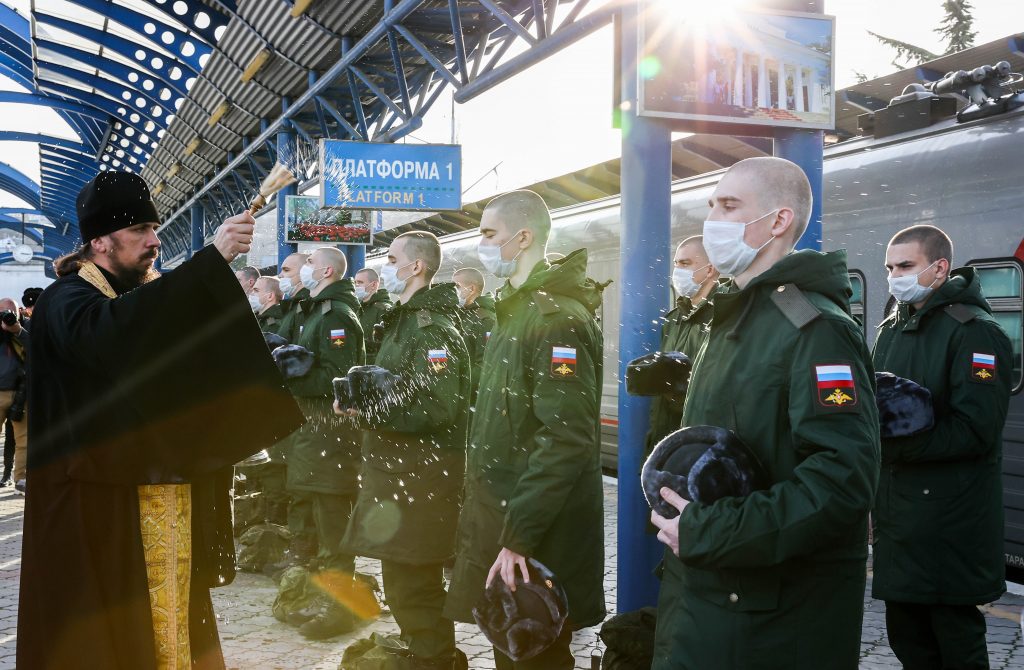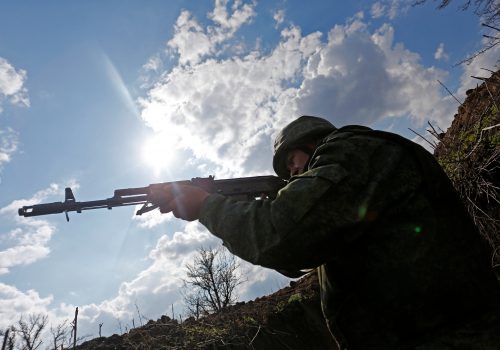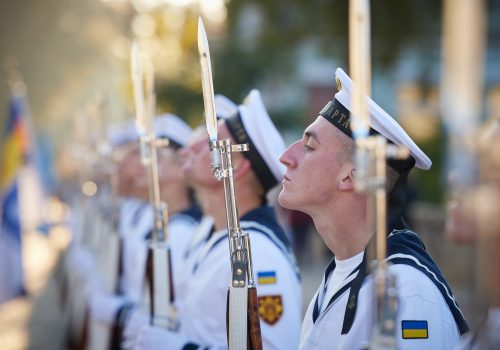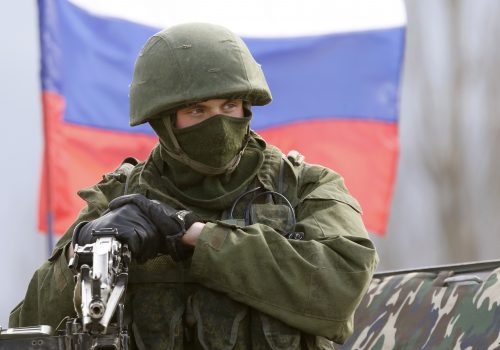Russian President Vladimir Putin has recently attempted to seize the initiative in his diplomatic duel with the West by presenting a comprehensive list of security demands while massing a formidable invasion force on the Ukrainian border. This thinly veiled threat has created the impression that Western leaders must either make sweeping concessions to the Kremlin or face the prospect of the largest European conflict since WWII.
However, there is a third option. The best way to prevent a full-scale invasion of Ukraine may be by increasing the military costs Putin would be likely to face if he chooses to roll the dice and launch a major new offensive.
Before exploring how to enhance Ukraine’s defensive capabilities, it is vital to underline the folly of continuing to appease Putin. Ever since Russia first attacked Ukraine in spring 2014, many within the democratic world have advocated policies of appeasement. Far from deescalating the situation, this has only made matters worse.
Eight years on, Russian aggression against Ukraine continues with no end in sight to the simmering conflict in eastern Ukraine’s Donbas region. Meanwhile, an evidently emboldened Putin is now seeking to dismantle the entire post-Cold War European security architecture and reestablish a Russian sphere of influence over Eastern and Central Europe.
At this point, any further accommodations would be extremely dangerous. If NATO leaders bow to Russian demands and agree to withdraw from the region or limit future cooperation with Ukraine, this will not have a calming effect on the Kremlin. On the contrary, Moscow would become even more convinced that negotiations at gunpoint should continue. This would make a major war in Ukraine far more likely, while also paving the way for additional acts of Russian aggression from the Baltic to the Balkans.
Rather than appeasing the Kremlin, the West must seek to make any further escalations prohibitively expensive. The unprecedented sanctions measures that are currently on the table in the event of a new Russian offensive against Ukraine are certainly a step in the right direction, but it is far from clear whether economic measures alone will be sufficient to deter Putin.
Russia has built up its international reserves to record levels in recent years and is currently well positioned to weather a severe sanctions storm. Indeed, Putin may regard the economic pain of Western sanctions as a price worth paying for the decisive geopolitical gains he envisages from a successful Ukrainian campaign.
In order to be effective, economic measures must be deployed alongside a convincing military deterrent. At present, Western military planners are primarily focused on Russia’s overwhelming advantages in terms of missiles, aviation, and naval capabilities. This has helped to convince many that a full-scale invasion of Ukraine is a realistic military objective because of its apparently high chance of success.
With the threat of invasion imminent, there is not much that the US or Ukraine’s other international partners can do to rapidly reduce the existing capability gap between Russia and Ukraine. Complex air or naval defense systems would take years to become fully operational, and would cost billions to acquire and sustain.
Other sophisticated weapons systems have similar limitations and would require extensive training before they could be deployed. Instead, Ukraine and the country’s partners should seek asymmetric answers to the formidable military challenges posed by Putin’s Russia.
Stay updated
As the world watches the Russian invasion of Ukraine unfold, UkraineAlert delivers the best Atlantic Council expert insight and analysis on Ukraine twice a week directly to your inbox.
If Putin launches a full-scale operation, Russian forces will face a combined Ukrainian military of around 500,000 personnel including a considerable reserve contingent. However, if Ukrainian troops operate in large formations, they will become easy targets for Russian airstrikes. Indeed, any Russian offensive would likely begin with a devastating air and missile campaign designed to wipe out Ukrainian armored units, fighter jets, and key elements of the country’s military infrastructure.
In such circumstances, it is likely that the Russian military will be able to advance deep into Ukrainian territory. However, holding this territory will be a different matter entirely.
Russian occupation forces will face highly motivated opponents fighting in familiar surroundings. By combining serving military units with combat veterans, reservists, territorial defense units, and large numbers of volunteers, Ukraine can create tens of thousands of small and highly mobile groups capable of attacking Russian forces. This will make it virtually impossible for the Kremlin to establish any kind of administration over occupied areas or secure its lines of supply.
The readiness of Ukrainians to defend their country should not be any doubt. Thousands joined impromptu volunteer battalions in spring 2014 when Ukraine was on the verge of being overrun by Kremlin forces. In recent weeks, a poll by the Kyiv International Institute of Sociology indicated that as many as one in three Ukrainians would be ready to participate in armed resistance to a Russian occupation.
The same poll found that a further 20% of Ukrainians would be prepared to engage in civil resistance efforts. Indeed, everything from opinion surveys to election results points to the fact that a Russian invasion would be deeply unpopular and Kremlin forces would find themselves operating in a hostile environment ideal for asymmetric warfare.
Eurasia Center events

An asymmetric approach to countering a possible Russian invasion does not imply a loss of overall military coordination. Ukraine’s regular armed forces would remain at the heart of the resistance movement and would retain command and control structures even while operating in smaller units in a seemingly decentralized manner.
Meanwhile, Ukraine’s Special Operations Forces (SOF) would play a crucial leadership role in guerrilla warfare efforts, and would be able to call upon the invaluable training and considerable investments made in recent years.
Ukraine already has the tools and the personnel in place for an asymmetric campaign against any potential invaders. However, the country’s partners can also make a significant contribution to further enhancing this deterrence factor by bolstering Ukraine’s ability to wage an effective insurgency.
While there is no time to supply Ukraine with complex weapons systems, there is a shopping list of items that could significantly raise the cost of a Russian invasion. The most expensive items on Ukraine’s short-term wish-list include portable air defense systems, anti-tank missiles, anti-ship missiles, and counter-battery radars. Drones of all kinds would be most welcome. Sniper rifles and anti-sniper equipment would also be extremely useful, as would large deliveries of night vision goggles, encrypted radio communication devices, and satellite communication devices.
The Ukrainian armed forces are battle-hardened and highly motivated. After eight years of undeclared war with Russia, the country as a whole is perhaps more psychologically prepared to defend itself than any other nation in today’s Europe.
Given the right equipment and tactics, Ukraine can dramatically reduce the chances of a successful invasion. A Russian offensive would be likely to make impressive initial progress, but could quickly unravel as occupation forces encountered relentless opposition from mobile units operating on home turf.
Ever the amateur historian, Putin is acutely aware of the damage caused to Soviet society by the invasion of Afghanistan. He no doubt recognizes the potential dangers of becoming bogged down in a brutal occupation of his own in Ukraine.
Recent polls indicate very little appetite among the Russian public for a major war against Ukraine. This absence of enthusiasm could soon turn to outright opposition if large numbers of coffins began returning to Russia from Ukraine.
Despite the risks involved, the Russian leader wishes to continue diplomatic negotiations while holding a gun to Ukraine’s head. He clearly expects the Western world to blink first. Putin needs to be reminded that Ukraine is not a helpless hostage and will fight back. The consequences of such a campaign for his own regime are entirely unpredictable and could end up being very costly indeed.
Andriy Zagorodnyuk is chairman of the Center for Defence Strategies. He is a former Minister of Defense of Ukraine (2019–2020) and was the head of the MOD Reforms Project Office (2015–2018).
Further reading
The views expressed in UkraineAlert are solely those of the authors and do not necessarily reflect the views of the Atlantic Council, its staff, or its supporters.

The Eurasia Center’s mission is to enhance transatlantic cooperation in promoting stability, democratic values and prosperity in Eurasia, from Eastern Europe and Turkey in the West to the Caucasus, Russia and Central Asia in the East.
Follow us on social media
and support our work
Image: Conscripts and an Orthodox priest at a railway station before departing for military service with the Russian Army. 3 December 2021. (Sergei Malgavko/TASS via REUTERS)




